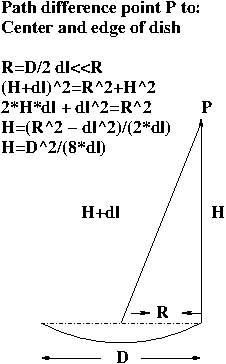
| radian |
2*pi radians in a circle |
circum=2pi*radius 360deg in circle rd=360/(2pi) |
| steradian |
AreaOfShere/radius^2 4pi steradians in complete sphere. |
4*pi*r^2 = area of sphere with r=1 1sr = 4*pi. |
| deg->radian |
57.29578 deg/rd |
360./(2*pi) |
| deg^2->steradian |
1sr=3282.81 d^2 sphere=41253 sq deg. |
1deg=(pi/180) radian 1deg^2=(pi/180)^2 ster |
| solid angle |
sa=2pi(1 -cos(th0) sr th0=1/2 angle of opening (in rd) 1sr when th0 = .572rd (32.8 deg) for gausian beam sr=pi*fwhm*fwhm/(4ln(2))=1.133 fwhm^2 (fwhm in rd) |
th0=1/2 angle areaSr=2pi*integral(dthsin(th)) 0 to th0 areaSr= 2pi(1 - cos(th0) 1sr when th0=.572 rd |
The path difference for rays from the opposite edges of the dish to a point P is:

We can define the near, far field transition as the height were dl
is a fraction of a wavelength:
dl=lambda/n = D^2/(8*H)
H=D^2/(8*lambda/n)
Some values are:
| wavelength
difference at P |
h |
| lambda/4 |
D^2/(2*lambda) |
| lambda/8 |
D^2/lambda |
| lambda/16 |
2*D^2/lambda |
The table below shows the transition region for some arecibo frequencies for different values of dl
| freq (Mhz) |
Lambda (m) |
Transition Region (Km) |
|||
| diam=305m |
diam=225m | ||||
| dl=lambda/8 |
dl=lambda/16 |
dl=lambda/8 | dl=lambda/16 | ||
| 327 |
0.917 |
101 |
202 |
55 |
110 |
| 430 |
0.697 |
133 |
267 |
72 |
145 |
| 1300 |
0.230 |
403 |
806 |
219 |
438 |
| 2380 |
0.126 |
738 |
1476 |
401 |
803 |
| 5000 |
0.060 |
1550 |
3100 |
843 |
1687 |
| 7000 |
0.043 |
2171 |
4341 |
1181 |
2362 |
| 9000 |
0.033 |
2791 |
5581 |
1518 |
3037 |
Using the hpbw to define the illuminated area (d=k*lambda/hpbw) and solving for H gives: